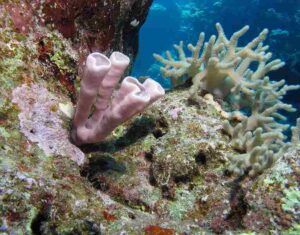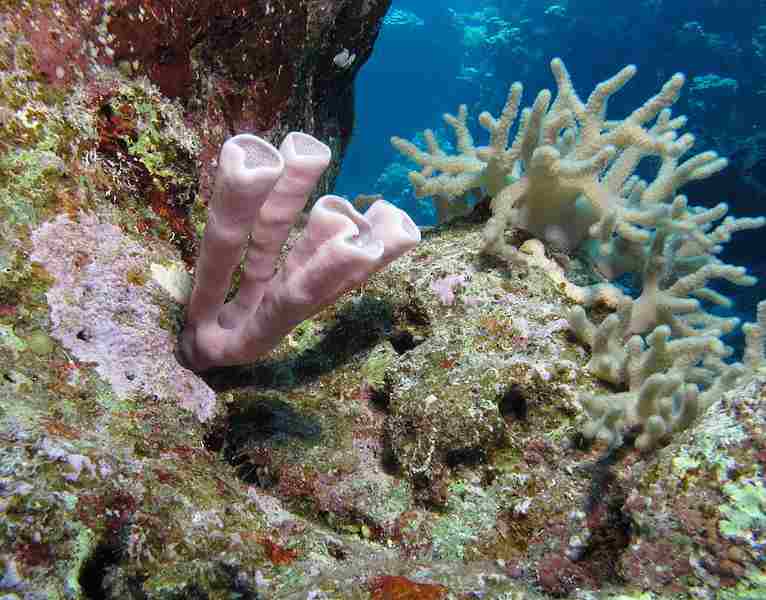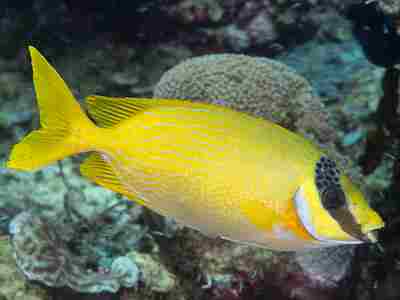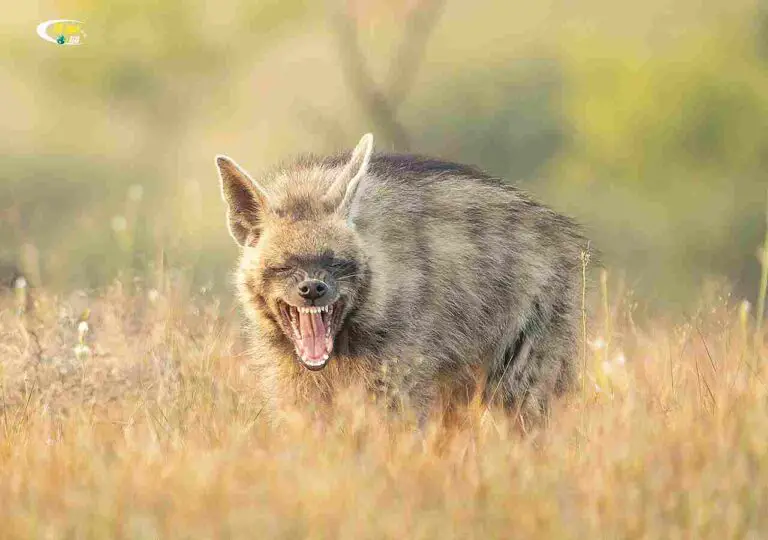Coral Reef Energy Pyramid Components and Processes
Coral reef energy pyramid comprises of producers, primary, secondary, tertiary and quaternary consumers; their energy gains, transfers, transformations and losses.
It can also be analyzed in terms of the contributions of decomposers to energy flow within the ecosystem.
This article discusses the coral reef energy pyramid components and processes, as follows;
1). Producers in a Coral Reef (as part of the Coral Reef Energy Pyramid)
In a coral reef ecosystem, primary producers have a critical contribution toward facilitating the transfer of energy through the food web.
These organisms are capable of harnessing energy from sunlight or inorganic compounds, and transforming it into chemical-stored energy in biomass, which forms the trophic foundation for the entire reef ecosystem [2].
Examples Primary Producers in a Coral Reef
Primary producers in a coral reef include; free-living phytoplankton, zooxanthellae, and seagrass.
Phytoplankton are a group of microscopic, single-celled algae that float within the water column. They are a major medium of primary production, and are responsible for a significant portion of the total photosynthesis occurring in coral reef ecosystems.
Various types of algae contribute to coral reef primary production, including micro, macro, green, red, and brown algae [5]. These organisms can be found in diverse forms, from encrusting algae to large seaweeds (macroalgae).

Zooxanthellae are symbiotic, dinoflagellate algae that usually live within the tissues of coral polyps. They are primary producers that provide their host with a source of energy through photosynthesis, and are essential for sustaining polyps that form the structure of coral reefs.
Seagrasses are a group of submerged, flowering hydrophytes that grow mostly in shallow coastal areas of coral reefs [3]. They are vital in their contribution to primary production, and can convert solar radiation into chemical bioenergy through photosynthesis.
The Role of Primary Producers in Energy Dynamics
In the coral reef energy pyramid, primary producers support energy transfer by serving as a basic energy resource, contributing to food web sustenance, oxygen cycling, and biodiversity support.
The ultimate source of chemical energy for organisms in a coral reef is the primary producers, which convert light from the sun to a usable form of energy for the ecosystem. Through photosynthesis, they create organic compounds like glucose, and store these in the tissues for heterotroph consumption.
As implied by their photosynthetic capability, primary producers constitute the basal level of the coral reef food web. They are consumed by a variety of organisms, including herbivorous fish, invertebrates, and even some corals that feed on plankton.
In the process of photosynthesis, primary producers release oxygen (as a byproduct) into the water [8], to the benefit of all aerobic organisms within the ecosystem, including fish and various invertebrates.
The species-richness and diversity of primary producers in coral reefs, provide a broad array of food sources for organisms in higher trophic levels, and support the intricate web of life in these ecosystems.
Status of Coral as a Primary Producer
Coral itself is not a primary producer, but is rather considered a primary consumer in the reef ecosystem. Corals obtain a significant portion of their energy and nutrients from the symbiotic zooxanthellae that live within their tissues, which are photosynthetic primary producers.
*How Primary Producers Obtain Energy in Coral Reefs
Primary producers in coral reef ecosystems obtain energy mainly through photosynthesis. They utilize chlorophyll and other photosynthetic pigments to capture sunlight and convert it into chemical bioenergy.
The process of photosynthesis in these organisms, involves the conversion of inorganic carbon dioxide and water, into glucose and oxygen, which are essential products for organic growth and survival.
2). Primary Consumers in a Coral Reef
Primary consumers in a coral reef ecosystem are a diverse class of organisms that are pivotal in their contribution to the transfer of energy from primary producers (such as algae and phytoplankton) to upper regions of the reef food chain.
These organisms are typically herbivores or filter feeders, and their distinctive feeding habits make them to function as a crucial link in the energy flow sequence of coral reefs.
Examples of Primary Consumers in Coral Reefs
Examples of primary consumers in coral reefs are; green turtles, zooplankton, and sea urchins.
Green turtles are marine reptiles that have herbivorous habits, and primarily feed on seagrasses and algae [4]. They are sometimes found in reef environments, where they play a key role in the maintenance of of seagrass beds and other autotrophic structures.
Zooplankton are small-sized, drifting animals that can be found in the water column. They typically feed on phytoplankton, which they may supplement with other microscopic food sources. Some examples of zooplankton in reef zones include copepods, small jellyfish, and krill.

Sea urchins are spiny, and round-shaped creatures that feed herbivorously, by grazing on algae growing on coral reef substrates. They possess specialized mouthparts which are used to scrape algae from the surfaces of corals and rocks.
The Role of Primary Consumers in Coral Reef Energy Pyramids
Primary consumers contribute to the sustainability of the coral reef energy pyramid through herbivory, energy transfer facilitation, and biodiversity support.
Herbivory refers to the process whereby primary consumers feed on producers like seagrasses and algae, thereby converting autotrophic biomass into energy. Through this process, they help regulate the growth of algae, as well as maintain the equilibrium of resources in the reef ecosystem.
As a result of their feeding activities, primary consumers cause energy to be transferred from the basal level of the food web (primary producers) to the higher trophic levels. This implies that they are an important link in the flow of primary energy to secondary consumers.
Lastly, the presence and speciation of primary consumers, help to support and boost the overall biodiversity of coral reef ecosystems. Primary consumers support biodiversity among predatory organisms, for which they provide a food source.
*Primary Consumers that Feed on Algae
Several primary consumers in coral reefs primarily feed on algae. These herbivorous organisms are therefore vital in controlling algal growth, which, if left unchecked, can smother/suffocate corals and disrupt the trophic balance of the reef ecosystem.
Primary consumers that feed on algae include; marine snails, shrimps, sea urchins, tangs and parrotfish.
3). Secondary Consumers in a Coral Reef (as part of the Coral Reef Energy Pyramid)
Secondary consumers in a coral reef ecosystem are organisms that occupy the trophic level directly above primary consumers (that is; Trophic Level 3).
They have a crucial role to play in the flow of energy within the ecosystem, as they feed on primary consumers, and effectively channel the energy obtained from these herbivorous and omnivorous organisms, to the higher levels of the food chain.
Examples of Secondary Consumers in Coral Reefs
Examples of secondary consumers in coral reefs are; starfish, large jellyfish, sea anemone, and several omnivorous fish species like butterfly fish, wrasse, triggerfish, filefish, and goatfish.
Wrasses are small and colorful fish that occur in coral reef zones. They mainly feed on marine worms, mollusks, smaller fish, and coral polyps; among many other organic materials.
Butterfly fish also have a distinctive appearance with striking patterns. They are known for their diverse diet, which includes coral polyps, and small invertebrates like zooplankton, sponges and worms. Butterfly fish have specialized adaptations that support their flexible diet.

Attributes of triggerfish include their beak-like mouths and powerful jaws, which they utilize for crushing and consuming hard-shelled invertebrates; and their diet includes mollusks, crabs, shrimps and sea urchins.
Filefish are typically herbivorous but can also exhibit omnivorous behavior by feeding on animal biomass. They possess small, pointed mouths which they use to pick at coral beds, extracting polyps and algae. Filamentous algae sponges are part of their diet.
Goatfish have long, barb-like chin whiskers which they use to to stir up sediments in search of food materials, that may be in the form of small invertebrates and crustaceans.
Trophic Role of Secondary Consumers in Coral Reefs
With respect to the coral reef energy pyramid, secondary consumers play two main roles, namely; energy transfer and trophic modulation through population control.
Energy flow through the coral reef ecosystem, is facilitated by the activities of secondary consumers. These organisms harness the stored energy in the biomass of primary consumers (which they feed on) and, as a result, contribute to the transfer of energy to higher trophic levels.
Preying on primary consumers is also a means for secondary consumers to regulate the abundance of herbivorous and omnivorous reef species. This, in turn, can affect the distribution and biological performance of primary producers, such as corals and algae, by preventing overgrazing, or even by inhibiting producer diversity that is associated with selective herbivory.
Secondary Consumers and Coral Consumption
Many secondary consumers in coral reefs do not feed on coral as a primary food source, although some, like certain butterfly fish, may include coral polyps significantly in their diet.
It is essential to note, within this context, that these secondary consumers often possess adaptive features like specialized oral morphology, that allow them to target and feed on coral polyps without causing damage to the entire coral colony.
4). Tertiary Consumers in a Coral Reef Ecosystem
Tertiary consumers in a coral reef ecosystem are advanced feeders, that are critical in maintaining ecological balance and energy transfer within the food web.
In the absence of quaternary consumers, these organisms occupy the topmost trophic level of the food chain, and typically feed on both primary and secondary consumers.
By controlling the populations of species in lower trophic levels, tertiary consumers help to regulate the overall energy dynamics of the coral reef ecosystem.
Examples of Tertiary Consumers in Coral Reefs
Examples of tertiary consumers in coral reefs are; whitetip reef shark (Triaenodon obesus), horn shark (Heterodontus francisci), groupers, moray eels, as well as other large predatory fish like king mackerel, giant trevally and barracuda.
Sharks are prominent among high-level predators in coral reef ecosystems. It must be noted that some shark species can be classified as higher consumers than others, by reason of superiority in size and feeding adaptations.
Within the coral reef environment, sharks have a diverse diet that may include herbivorous fish, rays, smaller sharks, mollusks, and marine mammals. They can be categorized as tertiary consumers because of their tendency to feed on other predatory species (secondary consumers) like jellyfish, which themselves prey on primary consumers.
Activities of advanced predators like sharks lead to a cascading phenomenon/effect, where their consumption of lower consumers affects multiple trophic levels and organisms in the ecosystem, including primary producers [6].
Groupers are formidable predators that are known to hunt cephalopods, smaller fish, and crustaceans. They are classified as tertiary consumers because they typically feed on secondary consumers, such as butterfly fish.
Moray eels are another example of carnivorous predators, that can be found inhabiting holes and crevices in the reef. They feed on a vast array of smaller fish and invertebrates, making them tertiary consumers in the reef ecosystem.
Some large predatory fish species, such as the giant trevally, barracuda and king mackerel, are fit to be classified as tertiary consumers, by reason of their size. They prey on smaller fish and may even consume other tertiary consumers like eels and groupers.

Roles and Significance of Tertiary Consumers in the Coral Reef
The roles and significance of tertiary consumers in the reef ecosystem can be summarized to include; population control, biodiversity maintenance, and energy transfer.
Tertiary consumers help to control the populations of both primary and secondary consumers. In the process of preying on these organisms, they also help prevent overgrazing of seaweeds, seagrasses and algae, and protect coral polyps from overexploitation by some omnivores.
This ensures that all major levels of the coral reef energy pyramid are well-represented, and supports ecosystem sustainability.
Diversity of reef species is maintained by tertiary consumers, as they exert predatory pressure that limits the abundance of certain prey species and prevents low-level overpopulation and/or resource depletion. This form of maintenance creates opportunities for multiple species to thrive.
Tertiary consumers help channel organic energy in an efficient manner, from the lower trophic levels toward the top of the energy pyramid. They are crucial role toward determining the stability and structure of the entire ecosystem.
Status of Coral as a Tertiary Consumer
Contrary to some classifications, corals are not tertiary consumers, but are rather primary consumers in the reef ecosystem.
They are sessile organisms that obtain much of their energy through a symbiotic relationship with photosynthetic algae called zooxanthellae. Corals do not actively prey on other animals; instead, they capture and absorb organic particles (and some living organisms) from the water and rely on the products of photosynthesis to meet their energy needs.
5). Quaternary Consumers in a Coral Reef Ecosystem (as part of the Coral Reef Energy Pyramid)
Quaternary consumers in a coral reef ecosystem are the topmost-level predators that operate within the energy pyramid.
This implies that they occupy the highest trophic level and feed on lower consumers (primary, secondary, tertiary) or other vulnerable quaternary consumers.
These organisms are often the largest, most evolved and/or most formidable predators in the ecosystem, and they have a vital contribution toward the ecological dynamics of coral reef communities.
Examples of Quaternary Consumers in Coral Reefs
Examples of quaternary consumers in coral reefs are; sharks, marine mammals, and saltwater crocodiles. The latter two (marine mammals and saltwater crocodiles) are not core inhabitants of reef zones, but often traverse these areas in their search for food, hence their inclusion in the coral reef energy pyramid.
While some sharks are classified as tertiary consumers, others occupy the quaternary level. These apex predators may include species like hammerhead sharks, tiger sharks, and bull sharks. They consume a variety of prey, including other (smaller) sharks, small-to-large fish, marine mammals, and seabirds.
Certain marine mammals occur in coral reef zones, such as dolphins and some seal species. These mammalian species are often quaternary consumers. They primarily feed on organisms like fish and squid, but may prey on small sharks and other marine mammals.
Roles and Significance of Quaternary Consumers in the Coral Reef
The coral reef energy pyramid benefits from the presence of quaternary consumers, through their activities and effects that include predatory regulation of population size/diversity, and energy flow facilitation.
As stated earlier, quaternary consumers are the absolute apex predators in coral reef ecosystems. For this reason, they exert a significant level of influence on the abundance, diversity and adaptation of organisms in lower trophic levels, including tertiary consumers.
By regulating the populations of tertiary consumers, quaternary consumers help to maintain the equilibrium of the coral reef ecosystem. They prevent overgrazing by herbivorous species, as well as excessive predation pressure from secondary and tertiary consumers, thereby ensuring the health and continuity of all major organic groups.
Though their activities, quaternary consumers channel energy effectively from the lower trophic levels to the top of the food web. They are essential in completing and sustaining the sequence of transfer of energy, through the ecosystem.
Overview of Quaternary Consumers in the Coral Reef
Quaternary consumers in the coral reef ecosystem are mainly sharks, along with certain marine mammals that feed on lower consumers. These organisms represent the pinnacle of the coral reef energy pyramid, and are vital for maintaining the equilibrium and functioning of the ecosystem.
*Dynamics of Energy Transfer and Loss in Coral Reefs
Coral reefs are highly productive and complex ecosystems where energy flows through various trophic levels, from primary producers to apex predators.
Understanding the patterns of energy transfer and loss within coral reef ecosystems is a critical requirement for analyzing their functioning, resilience, and global significance as part of the marine biome.
Below is a numbered and summarized outline of trophic levels in the coral reef energy pyramid and their contributions to the overall energy dynamics of the ecosystem;
1). Primary Producers
At the base of the coral reef energy pyramid are the primary producers, mainly zooxanthellae (photosynthetic algae that live within coral tissues), free-living phytoplankton, seagrasses, and some types of macroalgae.
These organisms survive by capturing solar energy and convert it into chemical energy through photosynthesis, that can be consumed and utilized by living organisms.
Total Available Energy (Trophic Level 1) -100%
2). Primary Consumers
Typically, the primary consumers in coral reefs are herbivores that feed on primary producers. These include various fish species like parrotfish, and some invertebrates. They obtain their energy by consuming algae, seaweeds, and other autotrophic organisms.
In an ideal hypothetical coral reef energy pyramid, the amount of energy available to primary consumers will be about 10% of that available to producers in the underlying level, and a similar pattern will follow for trophic levels above the primary consumers. This is in line with the 'ten percent rule' of Trophic Transfer Efficiency (TTE) [1].
Total Available Energy (Trophic Level 2) -10%
3). Secondary Consumers
Coral reef secondary consumers are carnivores and omnivores that can feed on primary consumers. They include organisms like predatory fish, and sea stars. These organisms acquire energy by preying on herbivores and other vulnerable primary consumers.
Total Available Energy (Trophic Level 3) -1%
4). Tertiary Consumers
Tertiary consumers are top-level predators in coral reefs. They feed on primary and secondary consumers, or vulnerable tertiary consumers.
Examples include sharks, moray eels, and barracudas. These predators play a crucial role in controlling lower trophic levels.
Total Available Energy (Trophic Level 4) -0.1%
5). Quaternary Consumers
Quaternary consumers occupy the highest trophic level in coral reef energy pyramids. They are the apex predators and feed on all lower and vulnerable consumers. This group includes large sharks and some marine mammals.
Total Available Energy (Trophic Level 5) -0.01%
*Energy Transfer in the Coral Reef Ecosystem
Energy flows through the coral reef ecosystem as organisms consume one another.
The energy transfer sequence/process is initiated with the conversion of solar energy into chemical energy by primary producers, through photosynthetic mechanisms. This chemical energy is transferred to herbivores (and omnivores) when they consume primary producers, and subsequently to carnivores as they prey on herbivores and other predators.
*Energy Loss(es) in the Coral Reef Ecosystem
Energy is lost at each trophic level due to factors such as; low digestion efficiency, metabolic processes, and heat production/release.
This loss of energy imposes a limitation on the number of trophic levels that can be supported by the ecosystem.
In general, only about 10% of the energy from any given trophic level is transferred successfully to the overlying one. This energy loss emphasizes the importance of primary producers in supplying a continuous influx of photosynthetic resources to support heterotrophs in higher trophic levels.
*Decomposition and Nutrient Cycling
Organic remains and waste materials in coral reefs, are subjected to biodegradation by bacteria and other microorganisms. This process releases nutrients back into the ecosystem, which can be taken up by primary producers for their nutrition and photosynthetic activity, thereby completing the nutrient cycle.
Further discussion on decomposition in coral reefs is provided in the following section.
*Contribution of Decomposers to the Transfer Dynamics of the Coral Reef Energy Pyramid
The rich and vibrant nature of many coral reefs is built upon intricate food webs and energy transfer dynamics.
While primary producers, herbivores, and predators play critical roles in these ecosystems, decomposers also have an important contribution to the overall energy pyramid of coral reefs. Therefore, understanding the role of decomposers is crucial for a well-rounded evaluation of nutrient cycling, ecosystem health, and the energy pyramid itself.
Some important factors related to reef decomposers and their energy-dependent functions, are enumerated below;
1). The Role of Decomposers in Coral Reefs
Decomposers in coral reefs include microbes like bacteria, fungi, and detritivorous organisms like crabs, shrimp, and certain marine worm species.
Their primary function is to break down organic waste materials, including dead organisms, and fecal matter, into simpler compounds. This decomposition process releases trapped nutrients such as nitrogen, carbon and phosphorus from biomass back into the ecosystem. It can be therefore described as a form of natural recycling.

2). Nutrient Recycling by Decomposers
Decomposers are pivotal role in the recycling of nutrients within coral reef ecosystems.
When reef inhabitants die, their organic remains sinks to the substrate (lithic sediments or carbonate reef material) or accumulates in crevices within the reef.
Decomposers act upon and break down these organic materials, thereby releasing nutrients back into the water column. The released nutrients are then taken up by primary producers, such as coral zooxanthellae and free-living algae, either through their root-like structures or by direct absorption from the water.
3). Reef Detoxification
Decomposers also aid in detoxifying the reef environment. They break down compounds that are potentially harmful to other organisms, including certain metabolic byproducts and manmade pollutants. This detoxification process helps to maintain water quality and ecosystem wellbeing.
The same concept is applied by humans in bioremediation, where natural decomposers are used to reverse or reduce the environmental impacts of pollution [7].
4). Energy Flow Within the Coral Reef
Decomposers indirectly contribute to the process/continuity of energy flow within coral reefs.
As they degrade organic matter, they typically release energy in the form of heat. Although this energy is not as significant or effective as that transferred through the activities of producers and consumers, it still contributes to the overall energy budget of the ecosystem.
5). Biodiversity Support by Reef Decomposers
Decomposers also contribute to the diversity of life in coral reefs.
They provide a rich source of food (in the form of partially-decomposed detritus) for various detritivores and omnivorous scavengers, such as shrimps and crabs. This supports the survival of diverse species and helps maintain complexity and ecologic balance.
6). Decomposers and Ecosystem Resilience
Decomposers also contribute to the ecological resilience of coral reefs.
By recycling essential nutrients and maintaining environment-quality, they contribute to the wellbeing and stability of the ecosystem. This can enhance the ability of the reef to withstand and recover from disturbances such as severe hydrological hazards and coral bleaching events.
Conclusion
Coral reef energy pyramid comprises of;
1. Producers
2. Primary Consumers
3. Secondary Consumers
4. Tertiary Consumers
5. Quaternary Consumers
It can also be evaluated in terms of;
a). Dynamics of Energy Transfer and Loss in Coral Reefs
b). Contribution of Decomposers to the Coral Reef Energy Pyramid
References
1). Barneche, D. R.; Hulatt, C. J.; Dossena, M.; Padfield, D.; Woodward, G.; Trimmer, M.; Yvon-Durocher, G. (2021). "Warming impairs trophic transfer efficiency in a long-term field experiment." Nature. 2021 Apr;592(7852):76-79. Available at: https://doi.org/10.1038/s41586-021-03352-2. (Accessed 11 September 2023).
2). Brodersen, K. E.; Litchtenberg, M.; Ralph, P.; Kühl, M.; Wangpraseurt, D. (2014). "Radiative energy budget reveals high photosynthetic efficiency in symbiont-bearing corals." The Royal Society, Journal of the Royal Society Interface 11(93):20130997. Available at: https://doi.org/10.1098/rsif.2013.0997. (Accessed 11 September 2023).
3). Campbell, S. J.; Kartawijaya, T.; Sabarini, E. K. (2011). "Connectivity in reef fish assemblages between seagrass and coral reef habitats." Aquatic Biology 13(1):65-77. Available at: https://doi.org/10.3354/ab00352. (Accessed 11 September 2023).
4). Cardona, L.; Pena, P. C.; Velasquez, A. (2020). "Contribution of green turtles Chelonia mydas to total herbivore biomass in shallow tropical reefs of oceanic islands." PLoS ONE 15(1):e0228548. Available at: https://doi.org/10.1371/journal.pone.0228548. (Accessed 11 September 2023).
5). Fong, P.; Paul, V. J. (2011). "Coral Reef Algae." Coral Reefs: An Ecosystem in Transition (pp.241-272). Available at: https://doi.org/10.1007/978-94-007-0114-4_17. (Accessed 11 September 2023).
6). Heath, M. R.; Speirs, D. C.; Steele, J. H. (2014). "Understanding patterns and processes in models of trophic cascades." Ecol Lett. 2014 Jan;17(1):101-14. Available at: https://doi.org/10.1111/ele.12200. (Accessed 11 September 2023).
7). Liu, S. H.; Zeng, G. M.; Niu, Q. Y.; Liu, Y.; Zhou, L.; Jiang, L. H.; Tan, X. F.; Xu, P.; Zhang, C.; Cheng, M. (2017). "Bioremediation mechanisms of combined pollution of PAHs and heavy metals by bacteria and fungi: A mini review." Bioresour Technol. 2017 Jan;224:25-33. Available at: https://doi.org/10.1016/j.biortech.2016.11.095. (Accessed 11 September 2023).
8). Richardson, K.; Bendtsen, J. (2017). "Photosynthetic oxygen production in a warmer ocean: The Sargasso Sea as a case study." Philosophical Transactions of The Royal Society A Mathematical Physical and Engineering Sciences 375(2102):20160329. Available at: https://doi.org/10.1098/rsta.2016.0329. (Accessed 11 September 2023).








